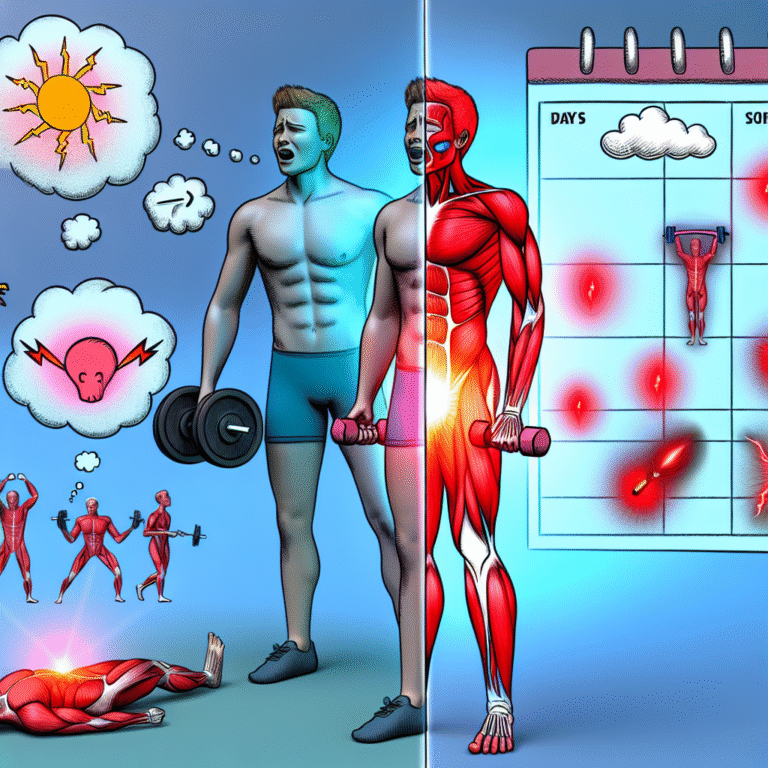Why Does It Take Me a Day or Two to Feel Sore?
- Delayed Onset Muscle Soreness (DOMS) is totally normal—it’s like your body’s delayed “thank you” for the workout.
- You might feel the burn two days later because of your body’s gradual response to new exercise, especially if you’re just starting out.
- Being overweight can influence soreness, but it’s not a game-changer—still, listen to your body!
So, you hit up that spin class, nailed those Pilates moves, and left feeling like a superstar. You even convinced yourself, “Hey, I could get used to this!” But come Day 2, your thighs and core are begging for mercy; what’s up with that?
Let’s unpack this phenomenon of soreness that feels like it popped out of nowhere and took you hostage. We’re diving into Delayed Onset Muscle Soreness, often abbreviated as DOMS. Honestly, don’t you just feel fancy saying that? But really, it’s a common experience for many, and I promise it’s nothing to fear.
The Science Behind the Soreness
So why do you feel sore after your workout rather than during it? It’s a head-scratcher! Let’s break this down:
Micro-tears in Muscle Fibers: When you exercise, especially in unfamiliar ways, you’re creating tiny tears in your muscle fibers. Your body reacts by building them back stronger, but not before it throws a little tantrum in the form of soreness.
Inflammatory Response: Those micro-tears trigger an inflammatory response, causing the area around the muscles to swell and get inflamed—a natural part of the healing process. That inflammation often translates to those “I’ve-been-working-out” aches and pains.
Timing of Pain: Here’s the kicker: soreness often peaks around 24 to 72 hours after the workout. This is because the inflammatory response takes some time to ramp up. Talk about a delayed reaction!
Why You Might Not Feel It Right Away
You took that spin class or Pilates session and were feeling all kinds of fabulous. But the next day? Crickets. So where’s the soreness? Let’s dive into some reasons this might happen:
Prime Muscle Usage: If you’re used to certain movements, your muscles may experience less trauma. Thus, they may not kick off soreness until the following day as they realize, “Uh-oh, what just happened?”
Gradual Introduction: When you’re just starting out or easing into a new routine, your body could need time to catch up, sorting through what it’s feeling as it adjusts.
Warm-Up and Recovery: You might also have nailed your warm-up and cooldown routines, helping mitigate immediate soreness. You thought ahead—smart!
Is This Normal for Newbies?
Let’s get real. You’re in a new workout groove, and you might be bringing your extra weight on this journey. But don’t worry; that doesn’t necessarily mean your body is destined for a life of constant soreness. It’s just your muscles trying to adjust to new movements!
Here’s the deal:
- For first-timers, soreness could be heightened due to lack of conditioning.
- If you’ve packed on some extra pounds, the intensity of your workout could be shared between the weight you carry and the muscle you’re building.
The Ups and Downs of Being New to Fitness
Advantages:
- Your body will become more efficient over time. The more comfortable you get, the less soreness you’ll experience in future workouts.
- A little soreness can mean you’re pushing yourself just right—enough to build strength but not so much that you’re flat out unable to walk.
Disadvantages:
- It could be a discouragement if you’re just starting out. Nobody wants to hobble like they’ve just taken a tumble from a bike!
- If you push too hard and experience extreme soreness, it could lead to injury—then you’ll need that workout cycle positivity to go on life support.
Listen to Your Body!
Here’s the bottom line, folks: Your body is a wandering little wonder. It has its own ideas about what feels good and what doesn’t. As you get into this fitness groove, take a moment to tune in to those signs it’s sending you. Soreness isn’t a badge of honor—it’s merely feedback.
Tips for Managing Soreness
If you find yourself wrapped up in soreness after a workout, here are some easy-peasy tips to help you cope:
Stay Hydrated: Drinking enough water helps flush out toxins and supports muscle recovery.
Gentle Stretching: Post-workout stretching can help relieve tightness. Think of it as your muscles getting a spa day!
Active Recovery: Engage in light activities like walking, swimming, or yoga to keep blood flowing to those sore muscles.
Rest: Your body needs time to heal. Don’t skip those rest days!
Nutrition: Fuel up on protein-rich foods to help repair those micro-tears in your muscles. Think chicken, beans, eggs—good stuff like that!
Here’s a fabulous comparison table that sums it all up nicely:
| Aspect | Feeling Sore Day After | Feeling Sore Two Days After |
|---|---|---|
| Body Response | Immediate inflammation | Accumulated muscle repair stress |
| Micro-tear Level | Lower post-activity | Higher due to activity overload |
| Conditioning Level | More familiar movements | New or intense activities |
| Projected Pain | Slight discomfort | More likely than Day 1 pain |
The Road Ahead
As you persist through your fitness journey, it’s key to remember that everyone’s body reacts differently. If you stay consistent, you’ll likely notice that satisfaction level of being sore begins to decrease over time, and you won’t feel that punch as fiercely. You’ll turn into the fitness guru you always wanted to be—a ton of fun and ready to dance through classes with the grace of a ballerina (okay, maybe that’s a stretch).
FAQs: Answering Your Burning Questions
Let’s tackle some common questions around fitness soreness, shall we?
Why does it hurt to walk after a workout?
Those micro-tears in your muscles from exercise are like tiny protests. They’re just letting you know they had to work hard!
How can I tell if I’m injured vs. just sore?
Good question! If pain is sharp and lingering for more than a few days without improvement, it might be worth consulting a pro. Soreness usually subsides within 72 hours.
Will I always feel sore after a workout?
Nope! As you get stronger and more accustomed to exercise, you’ll experience less soreness from your routine, but don’t be surprised if you feel discomfort occasionally when you mix things up.
Are there any supplements I should consider?
While nutrition is key, some folks swear by BCAAs (branched-chain amino acids) for recovery. Always check with a healthcare professional before diving into supplements.
The Bigger Picture
Getting through soreness is like crossing the finish line on a race track—it’s part of your journey toward crushing your fitness goals. Remember, patience is a virtue, and fitness isn’t a sprint, it’s a marathon (the fun kind, not the one where you feel like you’ll collapse at mile 12!).
So, lace up those sneakers, get ready for your next workout, and embrace the glorious journey that unfolds when you truly connect with your body after each spin class, Pilates session, or whatever floats your fitness boat. You’re doing amazing—soreness and all!
Keywords: soreness, DOMS, fitness, muscle recovery, workout, inflammation, hydration, nutrition, active recovery, exercise.





